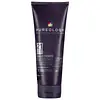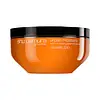What's inside
What's inside
 Key Ingredients
Key Ingredients

 Benefits
Benefits

 Concerns
Concerns

 Ingredients Side-by-side
Ingredients Side-by-side

Water
Skin ConditioningCetearyl Alcohol
EmollientAmodimethicone
Behentrimonium Chloride
PreservativeCetyl Esters
EmollientParfum
MaskingIsopropyl Alcohol
SolventTrideceth-6
EmulsifyingOlea Europaea Fruit Oil
MaskingCamelina Sativa Seed Oil
Skin ConditioningTocopherol
AntioxidantXylose
HumectantEthylhexyl Methoxycinnamate
UV AbsorberCetrimonium Chloride
AntimicrobialButylene Glycol
HumectantChlorhexidine Dihydrochloride
AntimicrobialLinalool
PerfumingHelianthus Annuus Seed Extract
Skin ConditioningBenzyl Alcohol
Perfuming2-Oleamido-1,3-Octadecanediol
Skin ConditioningGeraniol
PerfumingBHT
AntioxidantMelanin
Skin ProtectingPentylene Glycol
Skin ConditioningEthylhexylglycerin
Skin ConditioningWater, Cetearyl Alcohol, Amodimethicone, Behentrimonium Chloride, Cetyl Esters, Parfum, Isopropyl Alcohol, Trideceth-6, Olea Europaea Fruit Oil, Camelina Sativa Seed Oil, Tocopherol, Xylose, Ethylhexyl Methoxycinnamate, Cetrimonium Chloride, Butylene Glycol, Chlorhexidine Dihydrochloride, Linalool, Helianthus Annuus Seed Extract, Benzyl Alcohol, 2-Oleamido-1,3-Octadecanediol, Geraniol, BHT, Melanin, Pentylene Glycol, Ethylhexylglycerin
Water
Skin ConditioningCetearyl Alcohol
EmollientBehentrimonium Chloride
PreservativeGlycerin
HumectantAmodimethicone
Cetyl Esters
EmollientPotato Starch Modified
Isopropyl Alcohol
SolventMethylparaben
PreservativeTrideceth-6
EmulsifyingTocopherol
AntioxidantGlycine Soja Oil
EmollientChlorhexidine Dihydrochloride
AntimicrobialCetrimonium Chloride
AntimicrobialAlcohol
AntimicrobialSafflower Glucoside
Hexyl Cinnamal
PerfumingHydroxycitronellal
PerfumingPhenoxyethanol
PreservativeSodium Hydroxide
BufferingGentiana Lutea Root Extract
Skin ConditioningMoringa Oleifera Seed Extract
Skin ConditioningCorallina Officinalis Extract
Skin ConditioningDisodium Phosphate
BufferingCitric Acid
BufferingBHT
AntioxidantSodium Citrate
BufferingParfum
MaskingWater, Cetearyl Alcohol, Behentrimonium Chloride, Glycerin, Amodimethicone, Cetyl Esters, Potato Starch Modified, Isopropyl Alcohol, Methylparaben, Trideceth-6, Tocopherol, Glycine Soja Oil, Chlorhexidine Dihydrochloride, Cetrimonium Chloride, Alcohol, Safflower Glucoside, Hexyl Cinnamal, Hydroxycitronellal, Phenoxyethanol, Sodium Hydroxide, Gentiana Lutea Root Extract, Moringa Oleifera Seed Extract, Corallina Officinalis Extract, Disodium Phosphate, Citric Acid, BHT, Sodium Citrate, Parfum
Ingredients Explained
These ingredients are found in both products.
Ingredients higher up in an ingredient list are typically present in a larger amount.
This water-soluble silicone is used for its hydrating and softening properties. It is used to add a silky feel to skincare products and has great benefits for haircare.
In haircare, this ingredient:
- Adds shine
- Protects color
- Offers thermal protection
- Boosts hair strength
- Does not build up as easily
This ingredient is a preservative and often used for it's anti-static properties. You'll most likely see this ingredient in hair conditioners.
It does not cause irritation or sensitization in leave-on products at 1-5%.
BHT is a synthetic antioxidant and preservative.
As an antioxidant, it helps your body fight off free-radicals. Free-radicals are molecules that may damage your skin cells.
As a preservative, it is used to stabilize products and prevent them from degrading. Specifically, BHT prevents degradation from oxidation.
The concerns related to BHT come from oral studies; this ingredient is currently allowed for use by both the FDA and EU.
However, it was recently restricted for use in the UK as of April 2024.
Learn more about BHTCetearyl alcohol is a mixture of two fatty alcohols: cetyl alcohol and stearyl alcohol. It is mainly used as an emulsifier. Emulsifiers help prevent the separation of oils and products. Due to its composition, it can also be used to thicken a product or help create foam.
Cetearyl alcohol is an emollient. Emollients help soothe and hydrate the skin by trapping moisture.
Studies show Cetearyl alcohol is non-toxic and non-irritating. The FDA allows products labeled "alcohol-free" to have fatty alcohols.
This ingredient is usually derived from plant oils such as palm, vegetable, or coconut oils. There is debate on whether this ingredient will cause acne.
Due to the fatty acid base, this ingredient may not be Malassezia folliculitis safe.
Learn more about Cetearyl AlcoholThis ingredient is a preservative, antimicrobial, and emulsifier. It is often used in cosmetics for its ability to cleanse, condition, and reduce static.
Cetrimonium chloride is a quaternary ammonium salt, meaning it has a water-soluble structure.
Cetyl Esters is a synthetic wax made up of mostly fatty acids and fatty alcohols. It is strcturally similar to wax taken from whales.
As an emollient, it creates a thin barrier on the skin. This barrier prevents moisture from escaping.
This ingredient may not be fungal-acne safe.
Learn more about Cetyl EstersChlorhexidine Dihydrochloride is a preservative.
Isopropyl Alcohol is more commonly known as rubbing alcohol. It is most commonly used as a solvent, meaning it helps other ingredients dissolve.
This ingredient is an astringent alcohol. Astringent alcohols may also irritate skin as they high amounts may strip away your skin's natural oils.
Other types of astringent alcohols include:
According to the National Rosacea Society based in the US, you should be mindful of products with these alcohols in the top half of ingredients.
Any type of sanitizing product will have high amounts of alcohol to help kill bacteria and viruses.
Learn more about Isopropyl AlcoholParfum is a catch-all term for an ingredient or more that is used to give a scent to products.
Also called "fragrance", this ingredient can be a blend of hundreds of chemicals or plant oils. This means every product with "fragrance" or "parfum" in the ingredients list is a different mixture.
For instance, Habanolide is a proprietary trade name for a specific aroma chemical. When used as a fragrance ingredient in cosmetics, most aroma chemicals fall under the broad labeling category of “FRAGRANCE” or “PARFUM” according to EU and US regulations.
The term 'parfum' or 'fragrance' is not regulated in many countries. In many cases, it is up to the brand to define this term.
For instance, many brands choose to label themselves as "fragrance-free" because they are not using synthetic fragrances. However, their products may still contain ingredients such as essential oils that are considered a fragrance by INCI standards.
One example is Calendula flower extract. Calendula is an essential oil that still imparts a scent or 'fragrance'.
Depending on the blend, the ingredients in the mixture can cause allergies and sensitivities on the skin. Some ingredients that are known EU allergens include linalool and citronellol.
Parfum can also be used to mask or cover an unpleasant scent.
The bottom line is: not all fragrances/parfum/ingredients are created equally. If you are worried about fragrances, we recommend taking a closer look at an ingredient. And of course, we always recommend speaking with a professional.
Learn more about ParfumTocopherol (also known as Vitamin E) is a common antioxidant used to help protect the skin from free-radicals and strengthen the skin barrier. It's also fat soluble - this means our skin is great at absorbing it.
Vitamin E also helps keep your natural skin lipids healthy. Your lipid skin barrier naturally consists of lipids, ceramides, and fatty acids. Vitamin E offers extra protection for your skin’s lipid barrier, keeping your skin healthy and nourished.
Another benefit is a bit of UV protection. Vitamin E helps reduce the damage caused by UVB rays. (It should not replace your sunscreen). Combining it with Vitamin C can decrease sunburned cells and hyperpigmentation after UV exposure.
You might have noticed Vitamin E + C often paired together. This is because it is great at stabilizing Vitamin C. Using the two together helps increase the effectiveness of both ingredients.
There are often claims that Vitamin E can reduce/prevent scarring, but these claims haven't been confirmed by scientific research.
Learn more about TocopherolWe don't have a description for Trideceth-6 yet.
Water. It's the most common cosmetic ingredient of all. You'll usually see it at the top of ingredient lists, meaning that it makes up the largest part of the product.
So why is it so popular? Water most often acts as a solvent - this means that it helps dissolve other ingredients into the formulation.
You'll also recognize water as that liquid we all need to stay alive. If you see this, drink a glass of water. Stay hydrated!
Learn more about Water